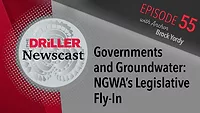Legislative Update
Workplace Injury Rate Declines - New Surface Mining Rules - EPA Planning Drinking Water Strategy - BLM Wants to Recover Costs - EPA new Radionuclide Rule
Workplace Injury Rate Declines Again
US Secretary of Labor Alexis Herman has announced workplace injury and illness rates declined in 1999, marking the seventh consecutive year the rates have fallen. The decline represents almost a 30% drop since 1992 and shows that employers and workers are making occupational safety and health a high priority, Ms. Herman said. The Secretary said injuries and illnesses dropped 4% in 1999 although employment rose 2% for the year. That means 200,000 less workers suffered job related injuries or illnesses than in 1998. Ms. Herman said those totals represent good news for business, workers and all Americans.BLM Publishes New Surface Mining Rules
A final rule that updates and strengthens the Bureau of Land Management's (BLM) 3809 surface mining regulations has been enacted by the federal agency. The new rule, which took effect Jan. 20, 2000, will enhance BLM's ability to protect public health, public land resources and the environment and will ensure that mining operations, rather than taxpayers, bear costs of reclaiming mined lands. The new rule follows the failure of several major mining regulations in recent years and the resulting cleanup costs having to be borne by taxpayers. The rule change marks the first time since 1980 that the BLM's 3809 rules, found in subpart 3809 of the agency's mineral rules, have been revised. Provisions of the new rule include that surface mine operators must submit a notice for all exploration activities disturbing five acres or less; operators must submit a plan of operations for all hardrock mining on BLM-managed lands, and allow BLM to withhold approval of a plan of operation if that operation would result in substantial irreparable harm to significant scientific, cultural or environmental resources that cannot be effectively mitigated, and mine operators would be required to provide a financial guarantee that covers the estimated cost of reclamation rather than the minimum per-acre amount currently allowed.EPA Team Planning Drinking Water Strategy
A Drinking Water Research Working Group has been established by the US Environmental Protection Agency (EPA) to consider agency research needs to support its regulatory issues affecting drinking water. The group is working on developing a Comprehensive Drinking Water Research Strategy. It will review research needs related to microorganisms, arsenic and other contaminants in the US drinking water supply. The new Drinking Water Research Working Group will be a part of the National Drinking Water Advisory Council.BLM Wants To Recover Costs Of Documents
The federal Bureau of Land Management (BLM) is proposing a rule to enable it to recover more of the costs associated with processing minerals-related documents such as applications for permits to conduct mining operations Eighteen new fees would be established and 22 existing fees would be revised under provisions of the proposed rule, which only affects the agency's minerals document processing, where costs are the greatest for document processing in the agency. One provision of the proposed rule would apply to case-by-case fees, where BLM fees vary greatly from one application to the next and another provision for fees to be set by category would apply to fees which are predictable and based on reliable data. The proposed rule could result in BLM recovering an additional $6.6 million annually in document processing costs. BLM officials will be accepting comments from the public on the proposed rule through Feb. 13, 2001 Copies of the proposed rule may be obtained from any BLM state office or the Washington, DC headquarters.EPA Announces Radionuclide Rule
The Environmental Protection Agency (EPA) has announced the final drinking water standards for (non-radon) radionuclides in drinking water. The rule involves revisions to the 1976 rule as proposed in 1991. The new rule requires community water systems serving at least 15 service connections or 25 residents regularly year-round to meet the radionuclide standard and the requirements for monitoring and reporting. Non-transient and non-community water systems will not be regulated under the new rule, but EPA may choose to regulate radionuclides in these systems in the future. Non-transient, non-community water systems are public systems which are not a community water system, but which serve at least 25 of the same people more than six months a year, such as in a school or nursing home. The new rule will take effect Dec. 8, 2003, three years after the final rule's publication date. New monitoring requirements will be phased in between that date and the beginning of the next Standardized Monitoring Framework period on Dec. 31, 2007. New monitoring provisions in the rule will help ensure all customers of community water systems receive water that meets Maximum Contaminant Levels for radionuclides in the drinking water. The rule includes a reduced standard for uranium in drinking water, meaning some 620,000 water system customers will be protected from uranium levels that could cause toxic effects to the kidney and possible cancer risk. The new rule also includes standards for radium-228, which are expected to reduce radium exposure for 420,000 water system customers. While many water systems have naturally occurring low levels of radionuclides, naturally occurring uranium, and radium-226 and radium-228 isotopes have been shown to accumulate to levels or concern in some drinking water sources.Looking for a reprint of this article?
From high-res PDFs to custom plaques, order your copy today!




